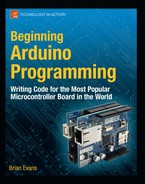Arduino is C… Mostly
In addition to the various aspects of the diverse Arduino ecosystem, we have the programming language of the Arduino platform, which is the central focus of this book. The core language used in the Arduino development environment is the C computer programming language first developed at the research institute of Bell Laboratories in the early 1970s for use with the UNIX operating system. C uses a procedural language syntax that needs to be processed by a compiler to map human-readable code to machine instructions. The long-standing popularity of C lends the Arduino some of its heritage, but the code that we are writing in this book is only mostly C.
Because there are aspects of the C language that look like it was written by dyslexic aliens, and with the language sometimes accused of being overly cryptic and difficult for beginners to pick up, the Arduino team has developed the standard Arduino library that provides a simple and targeted set of functions that make programming the Arduino interface board about as easy as it can get. Now, these libraries are themselves actually C++, itself a subset of the original C language, but we really don’t need to go there.
What’s important is that most of the code that we will write for the Arduino, including its syntax, structure, operators, control statements, and functions, remain fundamentally and functionally the same as C. What will be unique to the Arduino, however, are all sorts of functions that you will come to know and love, including pinMode(), digitalWrite(), and delay() that are specific to the standard Arduino library. For the purposes of this book, this basic framework of C combined with the additional Arduino library that is automatically a part of every sketch that we write, is what we will refer to as Arduino C. To illustrate this point, Listings 1-1 and 1-2 provide two examples of the same source code to blink the onboard LED connected to digital pin 13.
Listing 1-1. Blink LED with avr-libc
#include <avr/io.h>
#include <util/delay.h>
int main(void) {
while (1) {
PORTB = 0x20;
_delay_ms(1000);
PORTB = 0x00;
_delay_ms(1000);
}
return 1;
}
Listing 1-2. Blink LED with Arduino
void setup() {
pinMode(13, OUTPUT);
}
void loop() {
digitalWrite(13, HIGH);
delay(1000);
digitalWrite(13, LOW);
delay(1000);
}
These two different listings show two functionally identical sketches, one written with the Arduino library and one written without. The really nifty thing here is that, if you want to geek out, the Arduino development environment is fully compatible and extensible using C/C++ code written using the avr-libc library, a subset of the standard C library, and the GCC compiler, both written for Atmel’s standard 8-bit AVR microcontrollers. Listing 1-1 is written with avr-libc while Listing 1-2 is written using the Arduino library. They both are compatible with the Arduino development environment and can be uploaded the same way to the Arduino board. The first example also consumes a fifth of the amount of memory as the second example, coming in at 210 bytes as opposed to 1010 bytes.
What the Arduino example lacks in memory efficiency, however, it more than makes up for in usability and integration with the Arduino interface board. For example, referring to the digital pin that our LED is connected to as pin number 13 is generally easier for most people than the hexadecimal address 0x20 on PORTB. This simplicity is one the benefits to writing code using Arduino C. That is not to say that one is better than the other, but simply that this scalability and flexibility is an often-overlooked benefit of learning on the Arduino platform because it allows budding code-monkeys the opportunity to develop into ever more powerful architectures later. We will focus on programming the Arduino using the standard Arduino libraries, although if you want to know more, full documentation on the avr-libc library package can be found at www.nongnu.org/avr-libc/. While we are at it, it is also worth mentioning that it is even possible to program the Arduino interface board using other development environments more often associated with computer development, such as Eclipse, NetBeans, or any other development package that you are familiar with … or if you have an aversion to the color teal.
